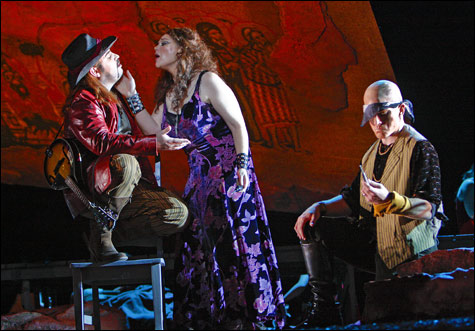BLO's Carmen, the BSO's Beethoven, Emmanuel Music's Haydn and Schoenberg
By LLOYD SCHWARTZ | November 12, 2009

CARMEN: Dana Beth Miller’s title heroine is a figure closer to melodrama than to tragedy, with no modulation in her voice or her acting. |
The Boston Lyric Opera comes maddeningly close to having a good Carmen. (The production continues at the Shubert Theatre through November 17.) Keith Lockhart leads a superb orchestra and chorus and a cast of plausible singers/actors in a compelling if not spine-tingling performance. BLO artistic adviser John Conklin has devised a spare split-level set, with a colorful multi-purpose banner raised or lowered or tilted to evoke by turns public square, mountain pass, and boozy hangout. Best of all, between Bizet's musical numbers we get the original spoken dialogue instead of the sung recitatives that were added after he died. (Carmen was composed for the Opéra Comique — which means its format is closer to musical comedy than to grand opera.) This both sharpens the dramatic interplay and fleshes out character. We learn, for example, that Don José studied to be a priest — which makes his hopeless passion for an amoral Gypsy cigarette girl, and his sacrifice of his dearest values, all the more devastating.
Nicholas Muni is the stage director who for BLO's I puritani, back in 1993, put the coloratura soprano into a straitjacket for the famous mad scene, making it hard for her to breathe. He has some novel ideas for Carmen: Carmen singing her fatal "Card Song" not to her superstitious friends but directly to Don José; Don José in a jealous rage thrusting his sword down the back of Zuniga's neck; Escamillo making his entrance after being gored by a bull. But some ideas are so distracting and silly, they get laughs. It's odd to have proper 19th-century bourgeois types parading in black top hats and parasols outside a seedy cigarette factory, or having Micaela, Don José's former fiancée, turn up in the final scene (in which she has nothing to sing) dressed in black and carrying a knife. Setting that last scene in toreador Escamillo's bedroom rather than outside the bullring eliminates the powerful irony of a private love affair taking place in public. Muni has Don José strangle Carmen instead of stabbing her, thus ruining Bizet's point of making her murder parallel to what we hear going on inside the bullring at that same moment. Entire productions — among them one of the BLO's, with Lorraine Hunt Lieberson, her only Carmen — have been built around that parallel.
There isn't a dull note in Carmen, so cutting out big chunks of the score will compromise even the most magnificent production. But that's what BLO has done. The casualties include Carmen's "Chanson bohème," the Gypsy song with her famous dance that gets the second act off to such a sensually exciting start. Without it, all the pacing is off. The act builds in excitement from Carmen's song and dance to Escamillo's entrance. Here he enters before anything has happened. The song seems the only moment in the opera in which Carmen is capable of forgetting herself. I felt shortchanged. Cutting operas is a bad old practice — there's no artistic justification. If saving money on overtime is the reason behind the cuts, then BLO should do shorter operas.
 Related
Related:
Lift every voice!, Mad love, John Harbison plus 10, More 
- Lift every voice!
Opera is the big word for 2009.
- Mad love
The destructive power of jealousy makes a good subject for opera.
- John Harbison plus 10
Classical music in Boston is so rich, having to pick 10 special events for this winter preview is more like one-tenth of the performances I'm actually looking forward to.
- Baroque and beyond
Ten-best lists usually come at the end of the season, but this year the Phoenix has asked its critics to provide a calendar of 10 events that, at least on paper, might wind up on an end-of-season Top 10. Boston, in case you didn't know it, is a great city for classical music, so it's not easy to keep the list short. But here goes.
- Contertizing
Boston Lyric Opera follows up Dvorák’s moonstruck Rusalka, with Christopher Schaldebrand in the title role of Mozart’s Don Giovanni, the BSO and much more.
- A song to sing, O!
Seiji Ozawa returns to the BSO, Boston Early Music Festival's 17th-century chamber operas, the Bostonians' Yeomen of the Guard
- Schnozzola!
By the time you read this, you've either seen or missed one of Boston's most exciting opera productions, Opera Boston's brilliant version of Shostakovich's The Nose .
- Noble melody
For the first time since James Levine became music director of the Boston Symphony Orchestra, this acclaimed Verdi specialist conducted the BSO in a Verdi opera.
- Woof!
Probably most music lovers wouldn’t head their greatest-composer list with Carl Orff, despite the popularity of his violent, garish, sumptuously tuneful Carmina burana .
- Blythe spirit
Leaving the Cutler Majestic after the opening night of Opera Boston’s latest Offenbach, La Grande-Duchesse de Gérolstein , you could see the smiling faces of an audience that had had a good time.
- Wanting more
After its triumphant traversal of the complete Béla Bartók string quartets at the Isabella Stewart Gardner Museum, the Borromeo Quartet was back for a free 20th- and 21st-century program at Jordan Hall, leading off with an accomplished recent piece by the 24-year-old Egyptian composer Mohammed Fairuz, Lamentation and Satire.
- Less

 Topics
Topics:
Classical
, Entertainment, Darren Anderson, boston lyric opera, More  , Entertainment, Darren Anderson, boston lyric opera, David Russell, Emmanuel Music, Dana Beth Miller, Dana Beth Miller, Carmen, Don José, Rafael Frühbeck de Burgos, Less
, Entertainment, Darren Anderson, boston lyric opera, David Russell, Emmanuel Music, Dana Beth Miller, Dana Beth Miller, Carmen, Don José, Rafael Frühbeck de Burgos, Less 